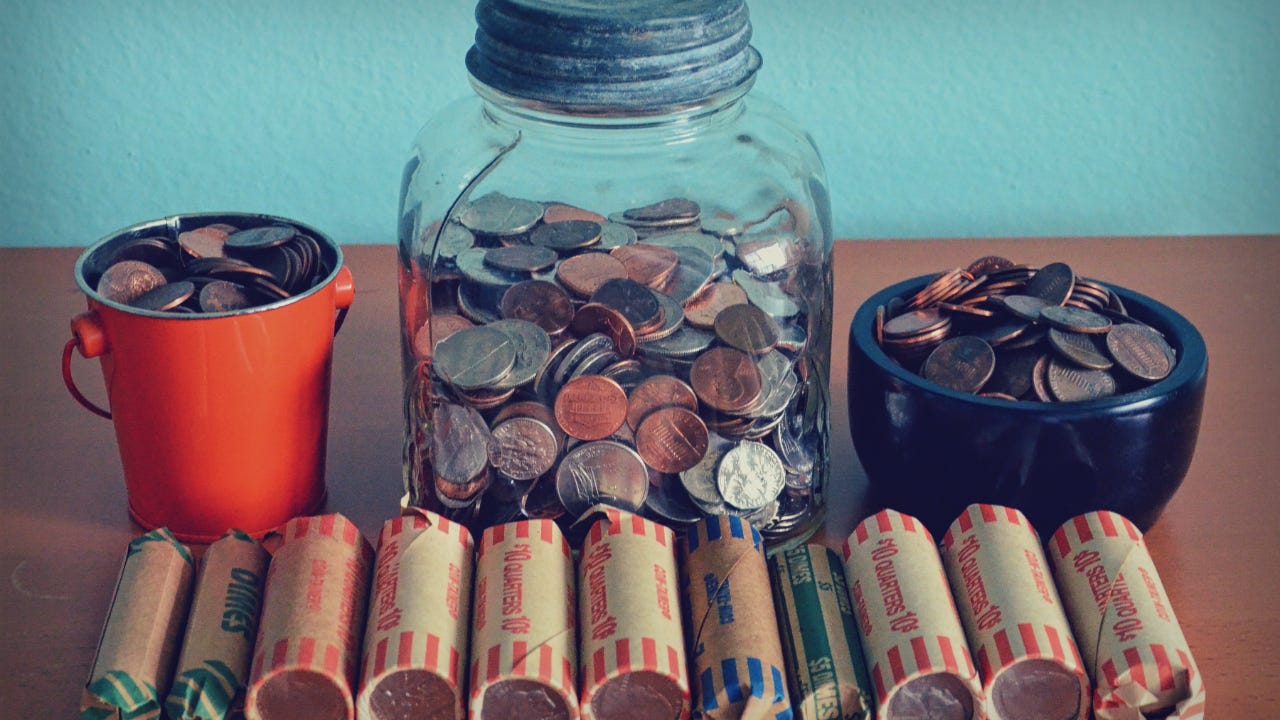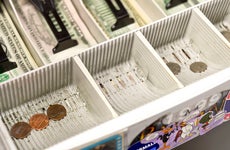The coin conundrum: Why coins are still scarce and how it affects consumers

The Bankrate promise
At Bankrate we strive to help you make smarter financial decisions. While we adhere to strict , this post may contain references to products from our partners. Here's an explanation for .
The coin shortage sweeping across the country didn’t vanish in the summer.
The production of coins is higher now than it was earlier in the year and banks are able to order more inventory than in June. But the pandemic-related disruption is forcing some changes at the cash register.
With fewer coins in their cash registers, stores of all kinds are requesting that you pay with exact change, credit cards or electronic mobile payments, Venmo included. Many supermarkets aren’t giving coins back even if you request them. They simply can’t. On Instagram, the hashtag #coinshortage shows people sharing pictures that range from the tongue-in-cheek (“Due to the coin shortage I’ll no longer accept anyone’s 2 cents”) to retailers’ payment pleas (“Due to a national coin shortage, exact change is appreciated on cash purchases when possible).”
It’s been an odd ongoing thing.
In the hunt for coins, some have raided gumball machines, pleaded to coin-rich, out-of-town family members to mail them some and even uncovered about 100 gallons of coins by draining an aquarium’s wishing well to pay the bills. To replenish their stockpile of coins, companies have also offered enticements to customers: Several Chick-fil-A locations offered free food for spare coins, while The Bank Of Utah gave out free piggy banks for customers bringing in extra coins (a campaign that caught on with kids coming in with their lemonade stand profits, per the report in the Deseret News).
The U.S. Coin Task Force, set up by the Federal Reserve, designated October #getcoinmoving month to inspire more consumers to dig their coins out of jars and sofa cushions and circulate them. According to a recent Coinstar survey, American adults estimated they had $113 of spare change, on average, in and around their home.
“There (are) plenty of coins out there,” says Chris Hill, senior vice president and chief financial officer at Bankers’ Bank of the West, and a member of the Fed task force.
But due to business and bank closures during COVID-19, normal circulation of coins through the economy was disrupted earlier this year, making coins harder to come by. And the impact of that widespread shock to spending habits continues to be felt in many places nationwide.
Are coins more available now?
Since mid-June, the U.S. Mint — which produces coins — has been operating at full production capacity, minting 1.6 billion coins in June, more than 1.65 billion coins in July and August and 1.4 billion coins in September. (In 2019, the Mint produced an average of 1 billion coins per month.) The Federal Reserve, which manages coin inventory, has been easing the allocation limits it set for what bank gets what amount of coins, too.
A PNC spokesperson said the availability of coins is still lower than usual, but financial institutions like PNC are now able to order larger quantities of coins from the Fed.
While it’s easing, the problem persists.
“It’s certainly improved but we are not out of the woods yet,” Hill says.
What caused the coin disruption?
The coin disruption was a quirky symptom of the pandemic. When the coronavirus hit in March, many companies temporarily closed or operated on leaner staffing models to help ensure their safety, including the Mint. But the amount of coins was never the main culprit.
During the lockdown, in-person spending with cash was eliminated at businesses that also had to temporarily close. Even if retailers stayed open, many consumers did not want to touch cash out of fear of catching germs. Some retailers wouldn’t, and may still not, accept cash either, preferring Venmo, Square and mobile wallets that require no touch. While contactless payments were already on an upswing prior to the pandemic, they are now surging and accelerating the trend.
“Maybe what would have taken seven years to unfold has been compressed into seven months because of Covid,” says Richard Crone, CEO and founder at Crone Consulting LLC.
Even the vendors that typically collect coins from machines at laundromats and arcades were on pause, meaning even those coins didn’t make their way quickly back into circulation. “That circle got broken in several spots, so what you have is what you have,” says Joan Baldi, assistant vice president and controller of SAFE Credit Union in California.
According to the Mint, recycling and retail transactions account for more than 80 percent of coins in the circulating coin supply chain.
A compounding problem
Banks, which have been sunsetting coin-counting machines over the years, order coin inventory regularly. Since coins take up space, storing large quantities is impractical, if not impossible at branches with smaller real estate footprints. “A lot of newer branches don’t put in those great vaults that you used to see when the branch took up the whole corner of the block,” Baldi says. “There’s a storage and security issue.”
Running low on coins hasn’t been a challenge at every financial institution everywhere, of course.
When SAFE Credit Union heard the Federal Reserve would reduce the number of coins financial institution could order, Baldi remembers thinking “whaaat?” While she was surprised, she knew the credit union didn’t want to experience the financial equivalent of a toilet paper shortage. Then, she had a quick aha moment. The Fed restrictions were per location and the credit union had only been ordering for one. “Suddenly, we discovered we had 20 other locations that could be used,” Baldi says.
So SAFE ordered coins for all their locations and stored them in a third-party coin vault to avoid overwhelming the individual branches. “We had almost no impact from it from a member standpoint,” Baldi says.
Even a piggy bank company only had to make a minor adjustment.
At Money Savvy Generation, a financial literacy company for children that sells piggy banks, sales haven’t slowed nor have corporate sponsorships. But the messaging for the four-slot machines — “save,” “spend,” “donate” and “invest” — has been fine-tuned.
“The only pivot we’ve had to do is to tell parents that maybe they need to have their kids take their coins that they have in their piggy banks — which is the money in Savvy Pig — and move it out into circulation,” says Susan Beacham, founder and CEO of Money Savvy Generation. “The money you have in your piggy bank can actually help with this disruption. Let’s get the coins moving. It’s not supposed to sit there forever. It’s a stopping place. It’s not a termination point.”
How the coin conundrum affects consumers
It’s easy to spot new and old complaints about the coin shortage on online threads. As one Reddit poster wrote: “I have a big jug of loose coins. Maybe now is a time to count them, roll them and deposit into my bank… I wish banks had a coin counter machine. Back in the day, they used to have them then they were removed.” As someone else wrote: “I am a manager of a gas station. Our bank has placed a hard 5 rolls per coin denomination per week. Luckily I stocked up on Nickels and Dimes but quarters and pennies will run out here shortly. Fun times.” Another person wrote, “I need quarters for my crappy apartment’s washer and dryer.”
If you are an observer of the payment space, the shift toward card and mobile payments wasn’t unforeseeable. These trends have been gaining momentum over the past few years and the pandemic only sped things up. But a lack of coins circulating in the system came as a jolt to many. And it highlights a growing problem in the U.S.: financial exclusion for the most vulnerable — consumers who don’t have bank accounts. Without an option to pay in cash, some people can find themselves in a bind.
“If coins aren’t there, then inevitably it’s going to be difficult to pay $2.88 for something or $3.90,” says Jack Gillis, executive director of the Consumer Federation of America, a consumer advocacy group. “Our concern is that retailers or sellers will tend to round up and things could cost more for those who can least afford it.”
It could also complicate other ordinary everyday tasks.
“It’s one thing to go to a grocery store and the grocery store says, ‘Well, I can’t give you coins, so we will round up or round down’ and you’re out a little bit, which can still be hard for them,” Hill of Bankers’ Bank of the West says. “But when you can’t wash your clothes and show up to work in clean clothes, that becomes problematic.”
Not everyone agrees that going cashless locks out those without bank accounts. New payment apps continue to multiply in the U.S., and not all of them require bank accounts to use.
This new guard views cash as a safety and security issue that no longer makes sense in a digital age. (Even pennies are worth less than they cost to make.) They are bullish on the notion that consumers without bank accounts can instead use their smartphones to connect to person-to-person and prepaid debit card apps.
Whether or when physical currency becomes extinct remains a heated debate in the banking industry. In the meantime, commerce goes on and in an economy not fully opened, merchants remain in pursuit of coins to accommodate the millions of consumers who still rely on physical currency.
“This is a time to help your neighbor, help your community by getting coins in circulation,” Hill says. “We don’t know what their situation is. They may need that to meet their basic needs.”
What you can do to get coins moving again
You help replenish coin supplies by cashing in your coins at:
- Your local bank
- The grocery store’s coin-counting machines
- Spend them at merchants (especially if you have exact change)
As the economy reopens and consumers return to stores, the coin conundrum is expected to resolve itself. But the when, of course, remains a mystery and is dependent on the pandemic itself.
“It’s gotten better but how much better,” says Lance Noggle, senior director of advocacy for payments and cybersecurity at the Credit Union National Association. “We don’t know if there will be an outbreak where people don’t want to leave their homes. A lot of it depends on the crisis itself—whether there is another outbreak and how that impacts peoples’ behavior going into businesses.”
Learn more:
Related Articles

Top high-yield savings accounts are now beating inflation. Here’s why that’s important


